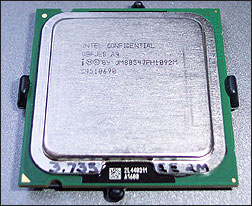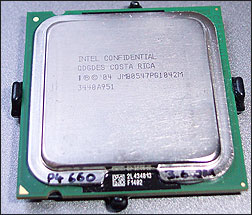Processor Examination
The new processors
I'll pick on a few examples of the current LGA775 processor cores in use today and present them in a table, so you can see the cores that span bus speeds and implement available processor features.| 570J | 3.4GHz XE | 3.46GHz XE | 660 | 3.73GHz XE | |
| Frequency | 3.8GHz | 3.4GHz | 3.46GHz | 3.6GHz | 3.73GHz |
| Core | Prescott-1M | Gallatin-2M | Gallatin-2M | Prescott-2M | Prescott-2M |
| Die Size | 112mm² | 237mm² | 237mm² | 135mm² | 135mm² |
| Bus Speed | 200MHz | 200MHz | 266MHz | 200MHz | 266MHz |
| Major pipeline | 32 stage | 20 stage | 20 stage | 32 stage | 32 stage |
| Transistors | 125M | 169M | 169M | 170M | 170M |
| Process | 90nm | 130nm | 130nm | 90nm | 90nm |
| Caches | 16KiB L1, 1MiB L2 | 8KiB L1, 512KiB L2, 2MiB L3 | 8KiB L1, 512KiB L2, 2MiB L3 | 16KiB L1, 2MiB L2 | 16KiB L1, 2MiB L2 |
| ISAs and ISs | x86, SSE->SSE3 | x86, SSE->SSE2 | x86, SSE->SSE2 | x86, x86-64, SSE->SSE3 | x86, x86-64, SSE->SSE3 |
| Power Techs | TM1, ACPI C0 (throttle only) to C3 | TM1, ACPI C0 (throttle only) to C3 | TM1, ACPI C0 (throttle only) to C3 | TM1->TM2, EIST, ACPI C0 to C3 | TM1->TM2, ACPI C0 to C3 |
You can see that Prescott-2M doesn't touch the basic integer pipeline of Prescott-1M, while adding support for the x86-64/AMD64 ISA, better thermal and power management and that 2MiB of L2 cache memory. What's interesting is that the 3.73GHz Extreme Edition, while being a Prescott-2M processor, doesn't support EIST.
Note that to fully support the non-throttle version of the C0 ACPI power state, the BIOS for the board the CPU is running must program the ACPI tables correctly for the correct processor.
So a range of 800MHz bus (four bus samples per clock, or quad-pumped as people like to call it) processors with the 6-series designation and a brand new Prescott-2M-based Extreme Edition at 3.73GHz on the 1066MHz bus. That now makes two processors to support Intel's latest bus frequency, both at $1000.
Pricing compared to the 5-series means you basically trade 200MHz for the ability to support 64-bit operating systems, EIST and 2MB of L2. There's no 680 at the launch of the processor, Intel not keen to release an $800 processor in between the 570J and 660, and the Extreme Editions. It's not clear if production of the 3.46GHz Extreme Edition stops now there's a new version, but if that's the case, it cements the 3.46GHz version as the rarest Pentium processor to hit market in recent times, having been around for less than three months at the time of writing.
Processor Appearance
Being LGA775 CPUs, the new processors all look the same. Being press samples that I get the privilege of testing, they're also unmarked with any meaningful information bar the slightly exciting Intel Confidential. So I draw on them. Not quite the Mona Lisa in miniature, mind you, rather an idea of what it is. Any retail example you purchase will be umblemished with my scriblings.They were supplied as PIB - processor-in-box - examples, complete with certificate of authenticity, guide to fitment and the retail heatsink. The heatsink for both processors is the same as Intel have supplied for recent Prescott-1M processors like the 570J.

Box label for 3.73GHz EE

Box label for Pentium 4 660
As you can see, the processors were packed late in January, suggesting they've been ready since at least December 2004 in terms of preparation for final sale and general availability. Indeed, the 6-series has been available to buy online for some time now, around the time the samples landed with press a week or so ago.











